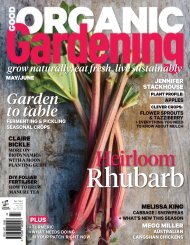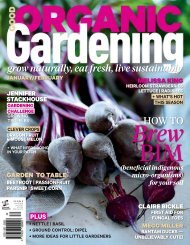6. Good Organic Gardening - November-December 2016 AvxHome.in
6. Good Organic Gardening - November-December 2016 AvxHome.in
6. Good Organic Gardening - November-December 2016 AvxHome.in
You also want an ePaper? Increase the reach of your titles
YUMPU automatically turns print PDFs into web optimized ePapers that Google loves.
and mammals such as antech<strong>in</strong>us by creat<strong>in</strong>g<br />
habitat for them <strong>in</strong> our gardens. In do<strong>in</strong>g so,<br />
we re-create the habitat we’ve taken away<br />
from these creatures.<br />
We also create wildlife corridors, which<br />
animals can use to travel from habitat to<br />
habitat, ma<strong>in</strong>ta<strong>in</strong><strong>in</strong>g genetically diverse<br />
populations and thus aid<strong>in</strong>g the survival of<br />
some threatened species.<br />
Frog ponds, when constructed with other<br />
animals <strong>in</strong> m<strong>in</strong>d, can be a fantastic way to<br />
provide habitat <strong>in</strong> our gardens, as they offer<br />
water, food and shelter for various species.<br />
The follow<strong>in</strong>g steps describe the creative<br />
process of build<strong>in</strong>g such a pond. The<br />
photos and the process were taken at Sean<br />
Morrow’s workshop at the Plant<strong>in</strong>g Festival,<br />
which has a strong focus on environmental<br />
susta<strong>in</strong>ability and happens each year at<br />
Woodfordia, the home of the Woodford Folk<br />
Festival <strong>in</strong> Queensland.<br />
Sean is a passionate wildlife habitat creator<br />
and gardener. His own garden is featured<br />
<strong>in</strong> our <strong>Garden<strong>in</strong>g</strong> Folk story on page 32.<br />
1<br />
Construct<strong>in</strong>g<br />
the pond<br />
Choose a suitable site where there is some<br />
sunlight but also some shade — aim for<br />
a balance between shade and sun. If the<br />
pond is fully exposed to the sun, algae will<br />
proliferate or the water will get too hot for<br />
frogs to breed <strong>in</strong> and their tadpoles will die.<br />
The water will also evaporate quickly and<br />
need constant refill<strong>in</strong>g. Too much shade, on<br />
the other hand, will reduce plant growth, while<br />
fallen leaves may <strong>in</strong>troduce too much organic<br />
matter at the bottom of the pond. If you have<br />
no shade, you can create a simple structure<br />
over the pond us<strong>in</strong>g shade cloth.<br />
1. Dig a hole about 50cm deep and 1.5×1.5m<br />
wide. The size of the pond is up to you,<br />
depend<strong>in</strong>g on your budget.<br />
2. L<strong>in</strong>e the hole with carpet l<strong>in</strong>er to protect<br />
the pond l<strong>in</strong>er from any potential damage.<br />
3. Carefully l<strong>in</strong>e the hole with pond l<strong>in</strong>er.<br />
4. Place rocks <strong>in</strong> the pond, be<strong>in</strong>g careful not to<br />
cause any damage to the l<strong>in</strong>er. Add differentsized<br />
rocks on the bottom to provide a range<br />
Build a frog pond | THE SHED<br />
What you need<br />
1. Mattock and shovel to dig a hole.<br />
2. Pond l<strong>in</strong>er — enough to cover the<br />
entirety of the hole and comfortably<br />
spill over the edges. For example,<br />
for a 1.5×1.5× 0.5m pond, you’ll need<br />
at least 3×3m l<strong>in</strong>er. The quality of<br />
the l<strong>in</strong>er you buy depends on your<br />
budget; the thicker it is, the more<br />
expensive it becomes. However,<br />
once the l<strong>in</strong>er is completely covered<br />
with rocks and logs, it will last for<br />
many years.<br />
3. Carpet l<strong>in</strong>er the size of the pond<br />
l<strong>in</strong>er (potentially available for free<br />
from carpet shops).<br />
4. Scissors.<br />
5. Rocks — enough to cover the<br />
entirety of the l<strong>in</strong>er — 1m 3 of rocks<br />
should be enough for a 1.5m pond.<br />
These should range from fist size up<br />
to 30cm.<br />
<strong>6.</strong> Logs — enough to decorate and<br />
stack up the outside of the pond.<br />
7. Mulch to fill the gaps between the<br />
logs and around the pond.<br />
8. Plants to grow around and <strong>in</strong> the<br />
pond (optional).<br />
9. Hose connected to a water supply.<br />
4<br />
Sean expla<strong>in</strong><strong>in</strong>g how to measure<br />
the length of the pond l<strong>in</strong>er<br />
down and across the bottom<br />
2 3<br />
Cover<strong>in</strong>g the hole with carpet l<strong>in</strong>er<br />
Add<strong>in</strong>g the pond l<strong>in</strong>er<br />
Snuggly fitt<strong>in</strong>g the l<strong>in</strong>er <strong>in</strong>to the hole<br />
<strong>Good</strong> <strong>Organic</strong> <strong>Garden<strong>in</strong>g</strong> | 69

















